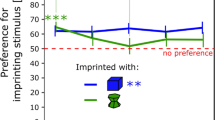Abstract
Three prenatal exposure conditions and 3 posthatch imprinting conditions (no sound Jay calls, and quail calls) were evaluated for their effect on following in Japanese quail chicks. The presence of prenatal sound had a significant effect on imprinting; birds exposed to jay and quail sounds prenatally followed significantly more than those exposed to no sound. Quail demonstrated no significant innate preference for the female call of the species. Auditory stimulation coupled with visual stimulation generates more following and imprinting than visual alone.
Similar content being viewed by others
References
COLLIAS, N. E. 1952. The development of social behavior in birds. Auk, 69. 127–159.
FABRICIUS, E. 1951a. Zur Ethologie Junger Anatiden. Acta Zoologica Fennica, 68, 1–175, cited by Sluckin, W. 1965. Imprinting and Early Learning. Chicago: Aldine.
FABRICIUS, E. 1951b. Some experiments on imprinting phenomena in ducks. Proc X International Ornithological Congress, 375–379, cited by Sluckin, W. 1965. Imprinting and Early Learning, Chicago: Aldine. P. 72.
FANCHER, D. 1971. The effects of prenatal auditory stimulation on imprinting behavior. Dissertation Abstracts International, 31 (11B), 6928.
FISCHER, G. J. 1966. Auditory stimuli in imprinting. Journal of Comparative and Physiological Psychology, 61(2), 271–273.
GOTTLIEB, G. 1963. “Imprinting” in nature. Science, 139, 497–498.
GRIER, J. B. 1967. Prenatal auditory imprinting in chickens. Science, 155, 1692–1693.
HESS, E. 1972. “Imprinting” in a natural laboratory. Scientific American, 111, 24-31.
KLOPFER, P. H. 1959a. An analysis of learning in young anatidae. Ecology, 40, 90–102.
KLOPFER, P. H. 1959b. The development of sound signal preferences in ducks. Wilson Bulletin, 71, 262–266.
LORENZ, K. 1935. Companionship in bird life; fellow members of the species as releasers of social behavior, cited by Schiller, C. H. (Ed.) 1957. Instinctive Behavior, New York: International University Press. Pp. 83–128.
PORTER, R., & STETTNER, L. 1968. Visual and auditory influences on following responses of bob white quail. Journal of Comparative and Physiological Psychology, 66(3), 808–811.
Author information
Authors and Affiliations
Additional information
We want to express appreciation for assistance in experimentation to Chris Bailey and Jan Morganthaler.
Rights and permissions
About this article
Cite this article
Ewing, A.T., Ewing, R.W. & Vanderweele, D.A. Imprinting in Quail as a Function of Pre- and Postnatal Auditory Stimulation. Psychol Rec 25, 333–337 (1975). https://doi.org/10.1007/BF03394324
Published:
Issue Date:
DOI: https://doi.org/10.1007/BF03394324




